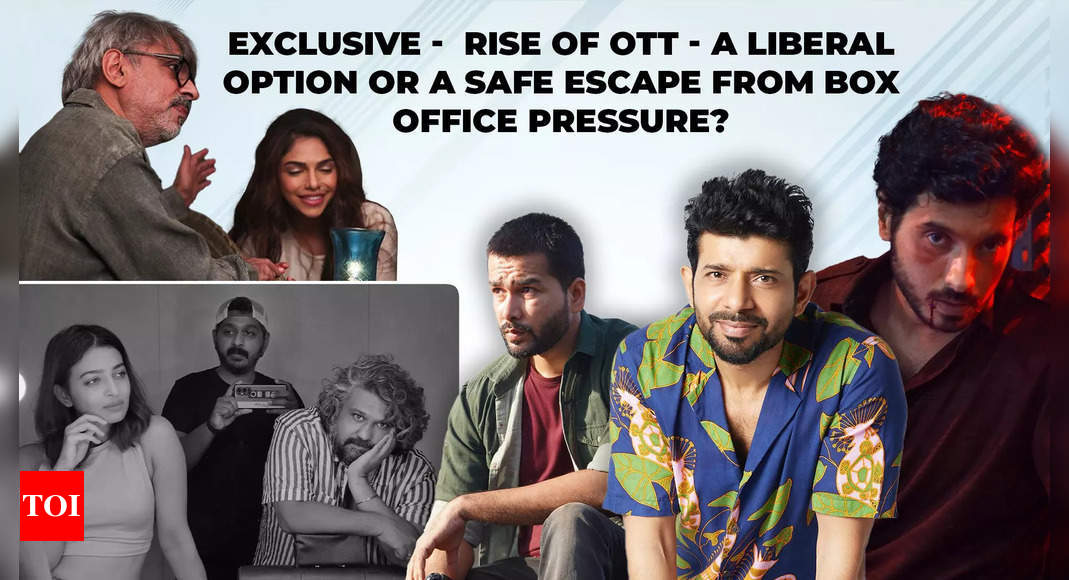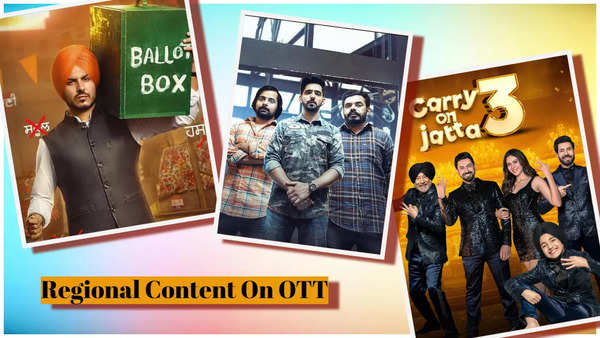
Is OTT being discreetly used as a safety net?
Recently, veteran filmmaker David Dhawan, known for delivering cinematic hits like ‘Partner’ and ‘Judwaa’, openly challenged OTT actors to prove their mettle in traditional theaters.In a conversation with Arbaaz Khan, Dhawan questioned the safety net provided by OTT platforms, where the success of a project often remains ambiguous. He urged actors to step into theaters and “show their worth,” sparking a debate about whether OTT is a liberating option for creative expression or simply a safe escape from the pressures of box office performance.
This statement by Dhawan opens up a broader discussion about the future of cinema, the changing dynamics of audience preferences, and whether OTT platforms are truly reshaping the industry or simply providing a refuge for content that might not stand the test of a theatrical release.
Does the medium matter?
It is worth noting that big banner movies, which traditionally thrived at the box office, are now making their debut on streaming platforms. High-profile films from renowned studios and directors are being released directly on OTT services. This year the ‘Padmavat’ fame filmmaker Sanjay Leela Bhansali, whose compelling storytelling and larger-than-life film sets have always melted hearts, also made his debut on OTT with ‘Heeramandi.’
Sharing his thoughts on the rise of the platform that reaches a wider audience, Sanjay Leela Bhansali in his conversation with ETimes mentioned “OTT platforms bring a lot of freedom to create what you want. You are not constantly under the pressure of box office performance, where your future career depends on the success or failure of your work.”
Sanjay Leela Bhansali: OTT Brings Freedom; You Are Not Constantly Under The Pressure of Box Office
“Of course, success and failure exist in this medium as well. If people appreciate it, then very good; they binge-watch, that’s great. If they watch it a second time, that’s even better,” he added “Whether people binge-watch or watch in segments, it’s important to me that they watch,” he said, highlighting that the most important thing is that people should watch it, the medium doesn’t matter.
Acclaimed filmmaker Anand L Rai added his perspective on the evolving landscape also echoes SLB’s viewpoint. He stated, “From a maker’s perspective, it’s a different vertical. There’s a definite audience for theatre. What do I want? I want a maximum number of people to see my story, my film. That is what I ask for. First, it was only theatre and satellite, and now there’s OTT too. I used to tell four stories earlier, but now I can tell six.”
Rai further emphasized the unique challenges and opportunities presented by OTT platforms and said, “OTT gives you a breather. But then you have to be very careful. You can’t put anything out. You have to respect your theatre-going audience and keep on working for them.”
He concluded by highlighting the irreplaceable experience of watching films on the big screen: “It can be taken in two ways – am I here only to make money? Then keep on doing whatever works for you. Or do you want to reach more people creatively? There’s an experience only theatres can give you. Some stories will be loved on the bigger screen only.”
Can OTT replace the big screen euphoria?
Digital platforms have provided a unique opportunity for many talented artists to showcase their skills without the pressure of box office performance. These digital platforms have allowed actors to build a different kind of fandom through their work online. However, even the actors recognize that while they no longer have to worry about cash registers ringing at the BO, OTT presents its own set of challenges.
“OTT has definitely taken away the pressure of the box office. We don’t need to make films only for theatres anymore. OTT has not just provided an alternate space for releasing films, it has brought the freedom of making different types of films as well. There is space for every type of work now. It doesn’t have to be as per box office success formula only. Studios even have the choice to decide if a film requires a theatrical release or it can be released on OTT directly. However, your film needs to click a good number of views to call itself a successful film. No average film can become a success just because it’s directly available on OTT,” said ‘The Family Man’ antagonist Sajid aka actor Shahab Ali.
“Having said that, I firmly believe that there are certain films that need to be experienced only in theatres. You just can’t have the same impact on the smaller screen. So it doesn’t matter how much you want to avoid the box office pressure, you will have to make it a theatrical release. It’s a matter of making the right choice,” he added.
Speaking about the antagonists of OTT, we reached out to the infamous Munna Bhaiya from ‘Mirzapur’ – Divyenndu for his insight on the matter. He said, “Just as we used to have satellite rights and theaters, I think OTT has become a third vertical. It’s a boon to our business that we now have this third stream of revenue—your theatrical release, satellite rights, and now OTT. This makes producers feel much more at ease while creating films or any kind of content.”
Divyenndu also believes that certain movies are meant for the big screen only, and that is not only because of the banner or studio bankrolling. It is more about the subject, the VFX, and much more. He elaborated on the same by citing examples of recent Hollywood and Bollywood releases and said, “For audiences, the bottom line is that they want to consume content. They are now very clear about what they want to watch on the big screen and what they prefer to view on their personal devices. Both have their own advantages. For instance, if you look at a big film like ‘Oppenheimer’, everyone wants to experience that on a big screen. Recently, ‘Stree 2’ is another great example. Before this, our film ‘Madgaon Express’, did pretty decent numbers on the big screen, and now it’s also available on OTT. People are very aware of what they want to watch and where they want to watch it.”
“Big screens offer a community viewing experience. At the same time, films watched on personal devices have a deep penetration throughout the country, enabling people from different regions to enjoy the content with the help of subtitles and language options. Both formats have significant advantages. This dual approach is only going to increase the reachability of content for filmmakers and audiences alike,” he concluded.
OTT gives hope to talent
Besides mainstream Hindi content, a lot of regional content is making its way to OTT as well. To gain some perspective on how the regional filmmakers, actors, and audience are reacting and utilizing OTT, we got in touch with Pollywood producer Sandeep Bansal of ‘Jatt and Juliet 3’ fame.
“A lot of movies are not released in theaters but are released on OTT, and these are individually produced movies and not originals; that’s separate. Even in the case of original content, OTT has become a launching pad for a lot of artists. A great example of this is ‘Sarpanchi,’ which stars Jass Bajwa,” he quoted.
For the audience, watching a movie on the big screen is much more than just consuming content. It is a whole experience. Sandeep Bansal added, “There will always be a demand for box office and people wanting to go out to the theatres and have the experience of watching a film in one with popcorn and sodas. OTT provides a separate parallel to entertainment and on-video demand and has a wide range of stories compared to the few movies that are released in theaters. So, it not only expands the canvas of content that’s there but also, at the same time, doesn’t eat into the box office collections. If a movie does well in theatres, it will do well on OTT as well. So, it mirrors the success of the movie. However, it might not be true in all cases, as many times, a movie might not have done well at the box office but might have been picked up well on OTT.”

“Even in Punjabi cinema, movies have started crossing the 100 crore threshold, and that’s after OTT has become very big. It’s the same for Bollywood. The entertainment market is growing overall. Where it matters most is where there are great stories but not a great star cast. Even today, the big trigger for people going to the theatres is a big star cast. In the case of OTT, however, you can push for better content stories and not just focus on the star cast. So that’s how it’s a parallel,” he concluded.
Amid all this discussion we also got a refreshing opinion from Neeraj Joshi the marketing head of Zee Studios. He said, “It’s actually the other way around now; with the streaming market entering a correction phase a lot of movies are now being linked to box office width of release and its performance.”
Talking along similar lines, filmmaker Vasan Bala added, “The pressure to deliver in views is still there. The show or the film still needs to reach out to the audience. On OTT there will always be claims of views which you believe because maybe it comes from a neural agency if they share the data but when something is a hit we know, it’s even more dependent on good reviews. You talk about it organically, you discuss it and suddenly you realize everyone is also. The pressure of success will always be there, there is no easy way of making a successful film. Box Office is a different metric, it’s traditional and also the highest aspiration too, it has a different business and emotion attached to it.”
Further, there is no denying that with OTT’s rise, movie filmmakers and actors are getting a chance to bring forth stories that were a part of their dream board for a long time. Good content is being pushed and more demand for the same is rising. Echoing the sentiment, producer-director Sejal Shah told us, “OTT has essentially also liberated filmmakers. Filmmakers can now make movies that they want to make and not just because the box office demands it. Also cast actors who suit the role and whom they want to work with and not someone who is saleable. The whole idea of OTT was that movies would be made and not ‘projects.’ I think OTT has taken the pressure of the box office but the audience still demands good content. As sitting at home they can just switch off within a few minutes.”
Vineet Kumar Singh On OTT vs Box Office: Important That A Movie Releases…Co-existence Is Beautiful
In conclusion, the rise of OTT platforms marks a significant shift in the entertainment landscape, offering filmmakers and actors a new space to explore creativity without the immediate pressures of box office performance. However, this freedom comes with its own challenges, as content must still capture and maintain audience interest in a crowded digital marketplace. While OTT has expanded opportunities for storytelling and broadened audience reach, the unique experience of watching films in theaters remains irreplaceable. The future of the industry will likely involve a balance between the innovative potential of OTT and the enduring appeal of traditional cinema, with the success of content ultimately determined by its ability to connect with viewers and endure beyond its initial release.





